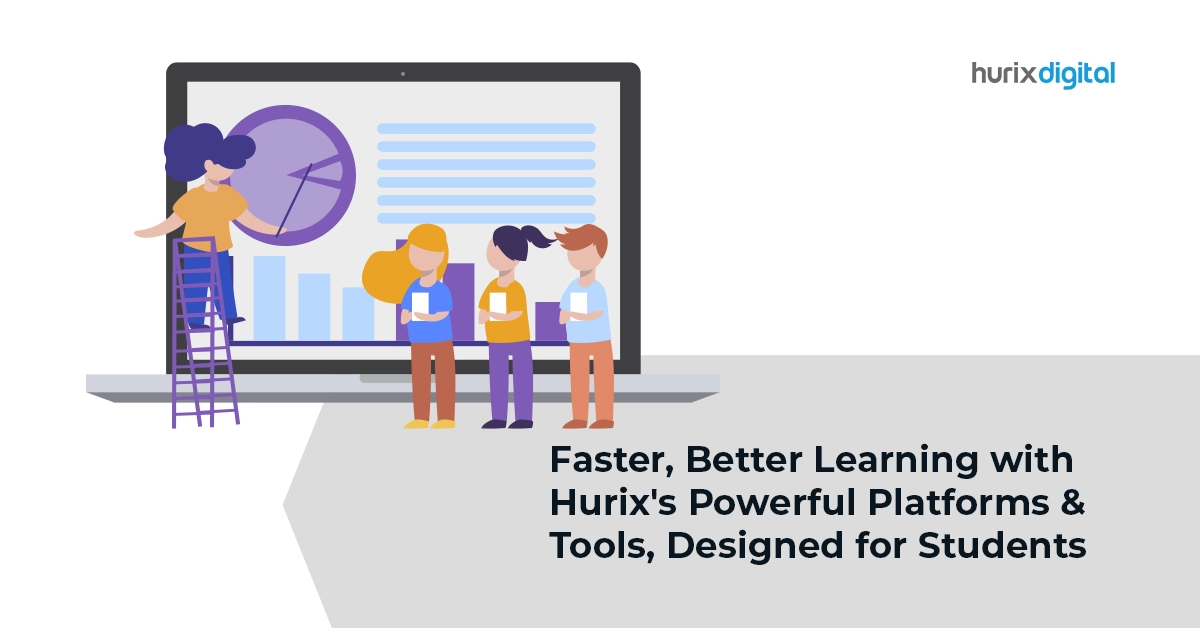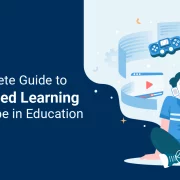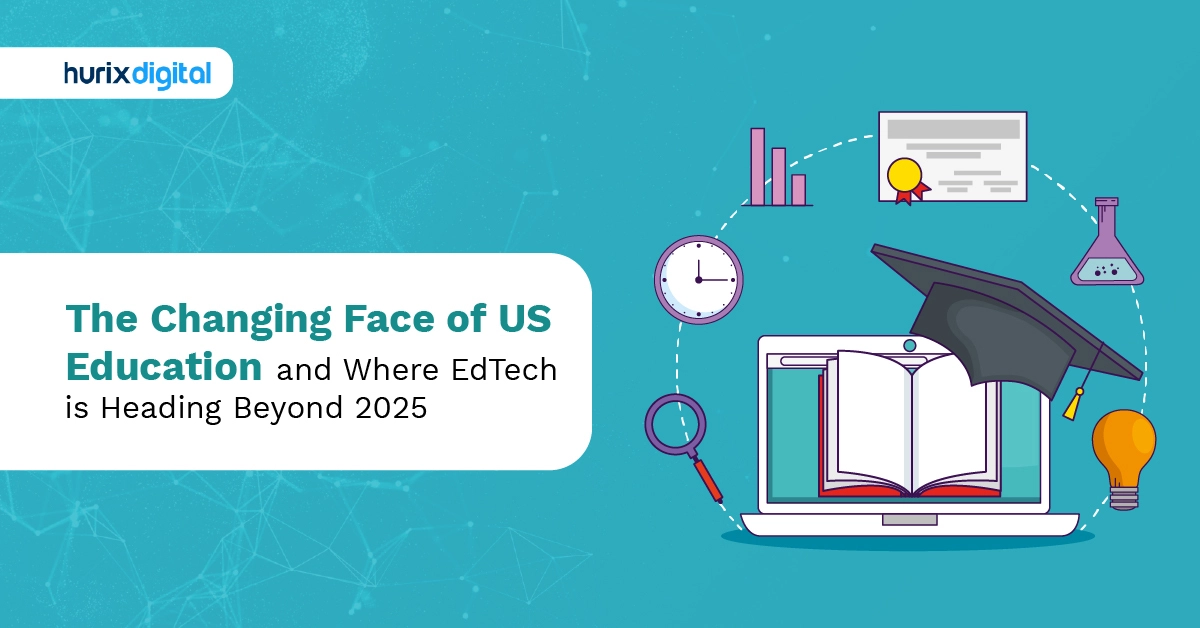
Trends in Higher Education – Future of EdTech in the US in 2025
Summary
Higher education in the U.S. is at a turning point. Enrollment is fluctuating, budgets are tight, and affordability is a growing concern. But there’s also opportunity—online learning, skills-based education, and EdTech innovations like AI are reshaping the future. To stay relevant, institutions must evolve and embrace these seven key trends in higher education strategically.
The landscape of US higher education is evolving. Enrollment numbers are holding steady post-pandemic, budgets are tightening, and there is a mix of interest and uncertainty about using AI and other new technologies in training.
With the increasing demand for skills that can be learned online, universities are realigning their strategies and focusing on providing accessible and flexible learning pathways.
However, this transition has its challenges and opportunities. The sector has witnessed a decline in enrollment numbers since 2011, with 20.3 million students enrolled in fall 2022/23.
This shift presents both challenges and opportunities for institutions, students, and educators alike. In this blog, we will explore the key issues and trends shaping the future of US higher education.
Table of Contents (Jump To):
- Challenges in the US Higher Education
- Opportunities in US Higher Education
- Strategies for Navigating the US Education Landscape
- Transparency and Representation
- Key Trends of EdTech in the USA
- Key Takeaway
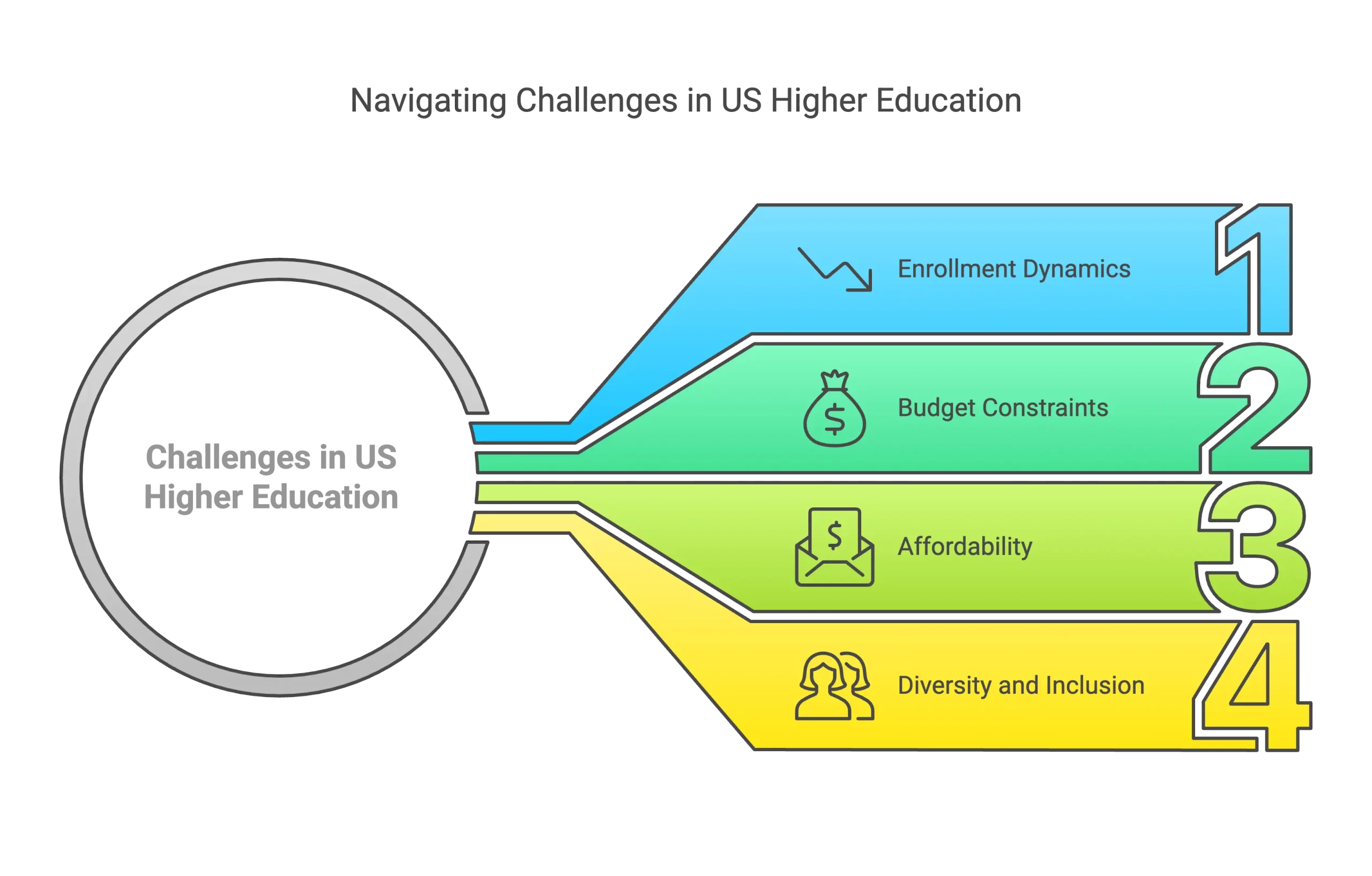
Challenges in the US Higher Education
Amidst the current US higher education landscape, several challenges stand tall and demand more attention and strategic solutions. Some of the challenges are stated below:
- Enrollment Dynamics
The pandemic has profoundly impacted enrollment numbers, with community colleges grappling with enrollment sustainability and smaller institutions facing closure.
In fall 2023, total college enrollment (graduate and undergraduate) was reduced by 4%, with undergraduate enrollment decreasing by 5.6% and enrollment at community colleges falling by 12%. Graduate enrollment, however, increased by 4.8%.
- Budget Constraints
With government funding declining, institutions are recalibrating their financial models to adapt to the changing landscape. Multi-year decreased state funding for public institutions and community colleges has significantly strained these institutions.
- Affordability
The rising cost of education has made it difficult for students to see the value of a college education, especially with the federal government spending $30 billion on Pell Grants for lower-income students in 2023. Over time, there has been a decline in the affordability of public four-year colleges and universities.
- Diversity and Inclusion
Ensuring equal opportunities and representation within higher education institutions is crucial for a more inclusive and equitable future. In the U.S., undergraduate enrollment grew 1.2 percent in fall 2023.
However, freshman enrollment only grew by 0.8%, driven by increases among older students, while enrollment of first-year students 20 years old and younger remains 5.3% below 2019 levels. Developing strategies to support students from all backgrounds in earning their degrees promptly will be essential going forward.
Opportunities in US Higher Education
Despite the various challenges faced, the current US higher education landscape presents numerous opportunities for innovation and growth. Here are some of the opportunities that it has to offer:
- Digital Transformation
The rise of online and hybrid programs presents an opportunity for institutions to adapt to the changing needs of students. According to a study by McKinsey & Company, 86 percent of new jobs projected to be created through 2030 are in fields such as nursing, teaching, and cybersecurity, which can be effectively taught through online and hybrid programs.
- Skills-Based Learning
The demand for skills that can be learned online is growing, offering a chance for higher education to focus on practical, job-ready skills. According to a recent study, the shift towards skills-based hiring has accelerated, with 55% of companies removing degree requirements, particularly for entry-level and mid-level roles, in 2023.
Moreover, over 80% of middle-skill jobs demand digital literacy. It is quickly becoming standard across higher-skill roles as well, highlighting the need for institutions to adapt their curricula to meet these emerging demands. Witnessed a reset in degree requirements.
This shift underscores the importance of hiring based on demonstrated skills and competencies rather than relying solely on traditional educational credentials. Thus, the curriculum must add skill-based learning to attract more students.
- Inclusivity and Representation
Embracing diversity and ensuring equal opportunities can lead to more inclusive and equitable decision-making. In a study by the National Center for Education Statistics, 61.4 percent of 2023 high school graduates were enrolled in college.
To improve access to higher education for underrepresented groups, institutions can focus on creating more inclusive environments and offering programs that cater to the needs of a diverse student body.
Strategies for Navigating the US Education Landscape
To navigate the complex landscape of US higher education, institutions must adopt strategic approaches that seize opportunities while addressing challenges head-on. Some of the strategies are:
1. Adaptive Approaches
Institutions must be proactive and adaptive to remain relevant and impactful in the evolving higher education landscape.
- Embrace the rise of online and hybrid programs to adapt to the changing needs of students.
- Collaborate with industries to bridge the gap between academia and industry needs, fostering agility in adapting to emerging workforce demands.
- Align strategic priorities with the growing demand for online and hybrid programs, recognizing their importance in providing accessible and flexible learning pathways.
2. Data-Centric Orientation
A data-centric approach can improve decision-making and drive institutional and student success.
- Analyze enrollment, retention, and student outcomes data to identify improvement areas and develop targeted strategies.
- Implement robust financial aid programs, academic support services, and initiatives fostering a sense of community and belonging to address the root causes of attrition.
- Utilize salesforce as the hub of a curated technology ecosystem, integrating with numerous communications tools and on-campus systems to streamline processes and boost staff productivity.
3. Transparency and Representation
Ensuring transparency and representation in decision-making processes can lead to more inclusive and equitable outcomes.
- To promote transparency, provide a more lucid and comprehensive account of the costs and outcomes associated with programs.
- Devise programs that cater to the needs of diverse student populations to ensure inclusivity and address the needs of underrepresented groups.
- Foster a culture of transparency within institutions to encourage open dialogue and promote equitable decision-making.
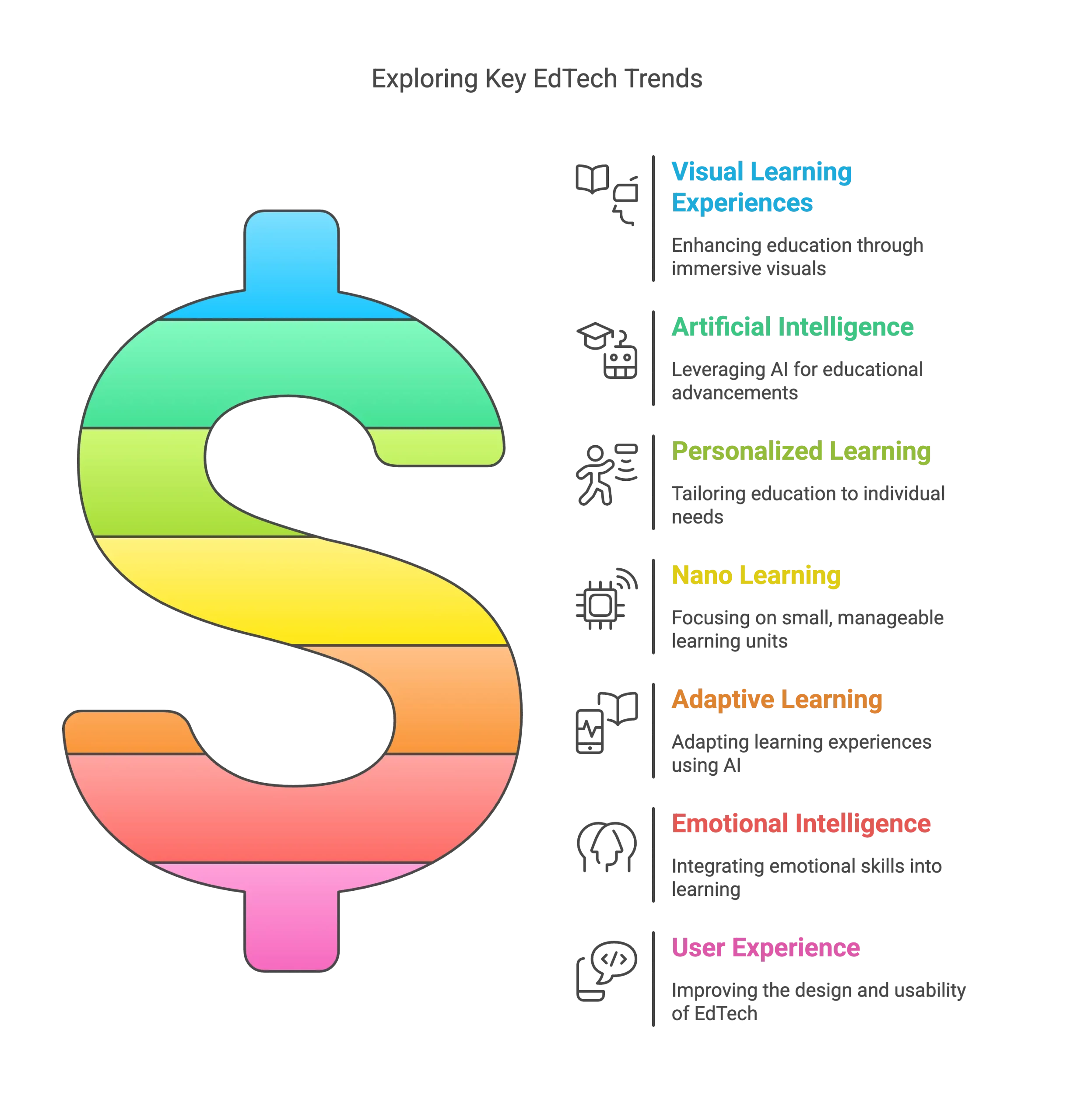
7 Key Trends in Higher Education in the USA
The size of the global EdTech market was estimated to be worth US$ 74.2 billion in 2021, and it is expected to grow at a rapid 14.5% CAGR between 2021 and 2031, reaching a total of US$ 288.4 billion by the end of that forecast period.
Here are some key trends and future predictions for EdTech in the USA.
1. Visual Learning Immersion Experiences
The information must be presented clearly for learners to remember it. While visual aids like films and PowerPoint presentations have long been used in the classroom, educators are starting to experiment with different display choices.
Thanks to cutting-edge AV technologies, teachers and students can share and stream incredibly clear images. These devices integrate camera equipment, magnifiers, and projection screens for educational purposes into a single, easy-to-use tool that is perfect for the classroom.
Even wireless instruments that work with various laptops, tablets, and other equipment are accessible to support special 1:1 learning plans. Access to software suites that combine multiple video streams and multimedia alternatives for teachers working with remote and hybrid students can improve many of these solutions.
2. EdTech’s Use of Artificial Intelligence
Artificial intelligence (AI) is one of the most important trends that will impact all industries in the future. It has become a global phenomenon. AI in education can help teachers and students in many different ways. They can automatically improve video streams so that cameras always follow the active speaker. To reduce the time teachers spend interacting with their technology directly, some cameras even include gesture controls.
The EdTech industry can assist administrators and school leaders in comprehending learner behavior and data, allowing them to customize the experience to meet each student’s specific needs.
Thanks to ChatGPT and other generative AI tools, the administration can now create artificial intelligence (AI) support that can instantly respond to student inquiries and provide round-the-clock study support.
3. Personalized Learning Opportunities
Studies show that students who receive individualized education and support perform better than 98% of their non-receiving peers. Leaders in professional, college, and school education are starting to realize how important it is to provide students with more individualized learning opportunities.
This could involve setting up one-on-one instruction for students who are having difficulty with a particular subject or using software to evaluate learner habits and performance and design personalized learning programs. Thanks to intelligent technology, teachers can now monitor every student’s progress in real time, which boosts student engagement.
Furthermore, technology-neutral solutions such as cameras and software for video conferences guarantee that students can stick with the tools they are most familiar with. This might entail giving students access to instruction and help via websites like YouTube, Microsoft Teams, and Zoom. In addition, EdTech in the USA can use gamification strategies—like leaderboards, reward points, and badges—to boost student engagement in learning environments.
4. Growing Implementation of Nano Learning
Due to their short attention spans and the constant demand for interesting material, students are drawn towards bite-sized learning materials like flipbooks, video tutorials, podcasts, and audio clips because they save time and energy.
Learners are looking for inclusive and easily accessible educational materials. They prefer unambiguous, visually compelling content that enhances the plot and can be administered in seconds.
Teachers are making progressive decisions about learning in their medium of directives, putting a greater emphasis on interactive knowledge creation.
5. Adaptive Learning Facilitated by AI
AI in education has made it possible to adjust in real time to students’ needs, offering the lessons and activities required to close knowledge gaps and solidify concepts.
Savvy, computerized tutoring systems have been growing for many years. However, it’s only been recently that processing power has increased to the point where artificial intelligence can be used for this intent on both local and cloud devices.
Chatbots with AI capabilities are also becoming more prevalent. For instance, chatbots like Duolingo use adaptive learning to teach foreign languages. Additionally, chatbots such as AdmitHub and Ivy.ai are serving as administrative assistants in higher education, offering assistance with everything from aid for tuition and living expenses to applying to colleges.
6. Integration of Emotional Intelligence into the curriculum
It is anticipated that emotional intelligence (EI) will be more deeply integrated into EdTech programs in the future. The creation of resources and tools that foster emotional intelligence will remain a priority for top EdTech companies in the USA as EI is becoming widely acknowledged for its contribution to academic and professional achievement.
It will grow more common to include stress management techniques, psychological wellness modules, and meditation sessions. Edtech in the USA will continue to center on how technology can support learners’ emotional wellness and overall growth, which reflects a broader societal awareness.
7. Upscaling User Experience
The field of user experience (UX) research is rapidly taking the EdTech industry by storm as it recognizes the critical importance of smooth interactions in learning settings. UX research, which examines user behaviors, preferences, and issues, is becoming more important for K12 EdTech companies. Teachers can create more user-friendly platforms by using the insights gained from this analytical approach.
Furthermore, this trend actively promotes more successful learning outcomes and raises user satisfaction. As EdTech in the USA becomes more pervasive, designing with the learner at the center guarantees that digital resources meet a range of requirements and learning styles.
Key Takeaway
Growing trends of EdTech in the USA include a wide range of tools and approaches, with a focus on chatbots, simulated tutors, AI-assisted instruction, UI/UX advancement, blockchain data safety, subscription-based training platforms, and more.
By carefully and strategically implementing these Trends in Higher Education 2025, we can create a more equitable, personalized, and engaging education system while enabling students to realize their greatest potential.
If you are looking for cutting-edge EdTech solutions to upscale your learning outcomes, contact Hurix Digital. We offer educational institutions the best digital solutions and online teaching platforms. Using revolutionary technology and software, we develop personalized educational programs to meet any company’s requirements.
Connect with us for more info!

Senior Vice President – Business Development
Over 25 years of experience in the edtech and workforce learning industry with strong skills in Business Development, Customer Relationship Management (CRM) and Strategy.



